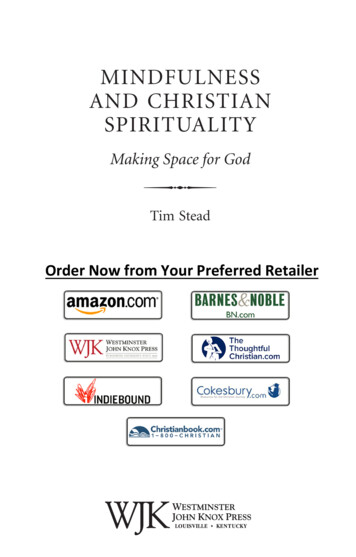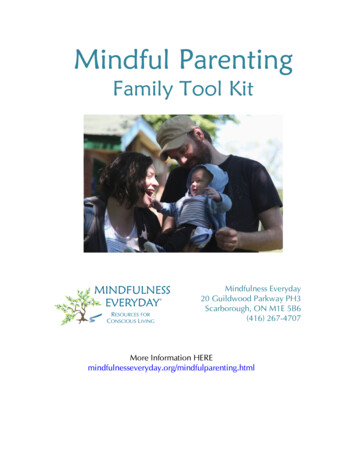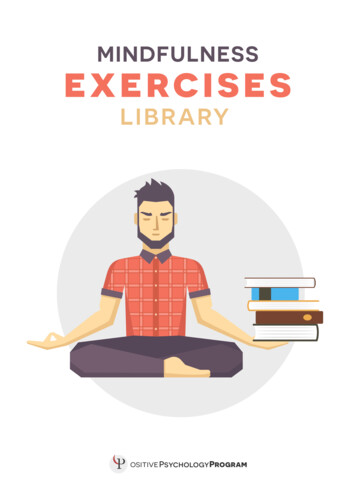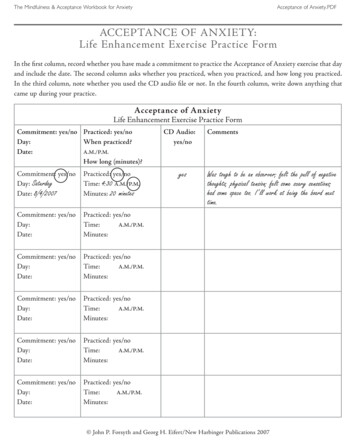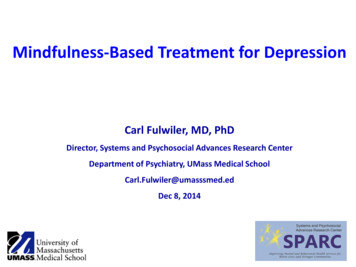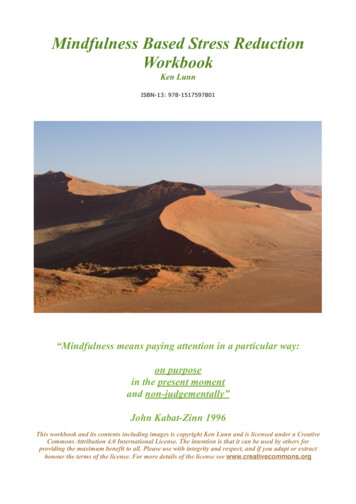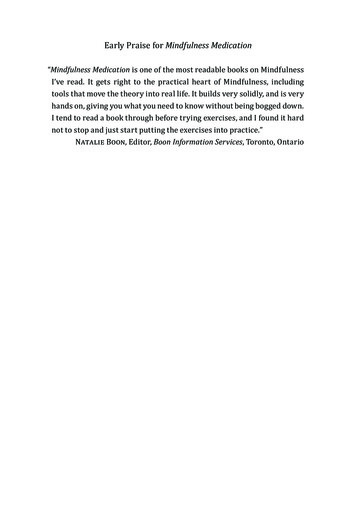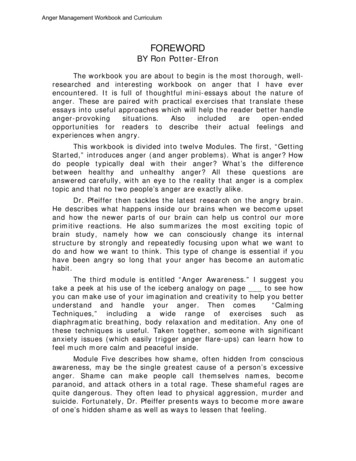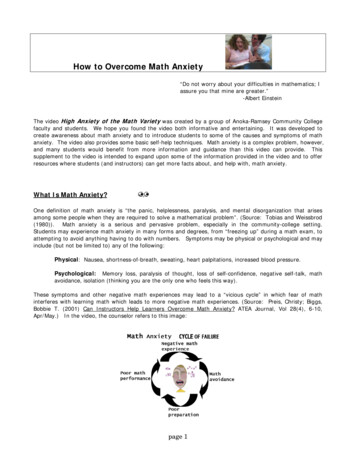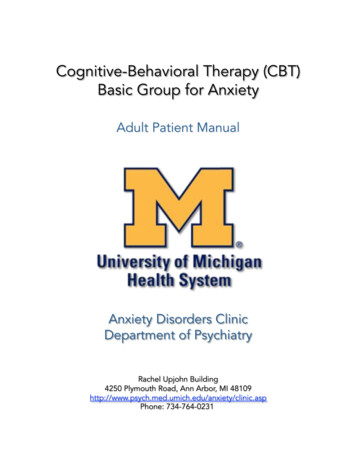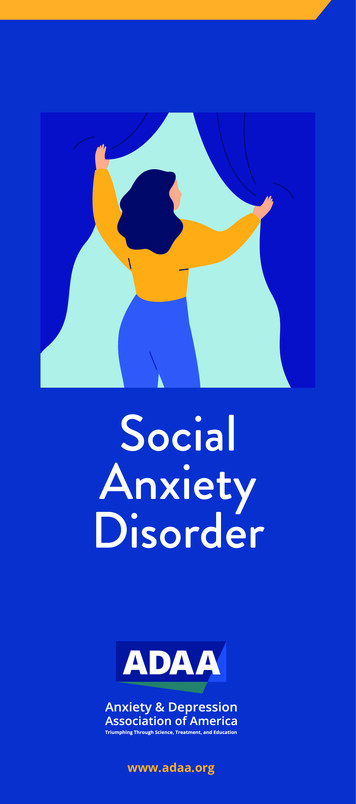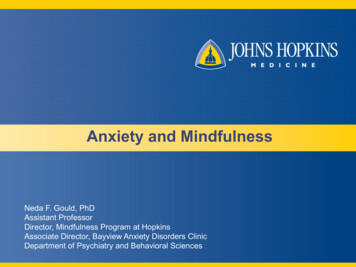
Transcription
Anxiety and MindfulnessNeda F. Gould, PhDAssistant ProfessorDirector, Mindfulness Program at HopkinsAssociate Director, Bayview Anxiety Disorders ClinicDepartment of Psychiatry and Behavioral Sciences
What is Anxiety? A state of fear resulting from a realisticor imaginary threatening situation May have emotional, cognitive andphysical components Anxiety can be a normal and healthyresponse to a situation
Anxiety vs. Anxiety Disorders Difficulty functioning in daily life– Occupational, academic, social/relationships Feel frequently overwhelmed or unable tocope with the anxiety Anxiety is excessive Using drugs/alcohol to deal with anxiety
Common Anxiety Disorders Panic Disorder (with Agoraphobia)Obsessive-Compulsive DisorderGeneralized Anxiety DisorderSocial Anxiety DisorderSpecific PhobiaPost-Traumatic Stress Disorder
Anxiety Disordersare Treatable
Cognitive-Behavioral Therapy (CBT) Short-term (6 to 20 sessions) Present-focused Can be equally effective as medication foranxiety disorders Combination Meds CBT often used
Cognitive-Behavioral Therapy (CBT)ThoughtsBehaviorsFeelings
Cognitive-Behavioral Therapy (CBT)1) Thoughts– Challenging Automatic Thoughts: Am I 100% sure that ? What evidence do I have that ? What is the worst that could happen? Howcould I cope with that?
Cognitive-Behavioral Therapy (CBT)2) Behaviors– Exposure-based Interventions– Relaxation or Mindfulness Exercises
Cognitive-Behavioral Therapy (CBT)2) Behaviors– Exposure-based Interventions– Relaxation or Mindfulness Exercises
What is Mindfulness?
What is Mindfulness? Bringing attention to the present moment Not focusing on what things should orcould be like Turning towards our experiences, even ifthey are difficult The opposite of mindfulness? Mindlessness and Auto-pilot
What gets in the way ofmindfulness? Thinking– To do list– Worrying– “Stories”– Catastrophizing Multi-tasking Technology (CELL PHONES) COVID-19
When can we practice mindfulness? In every moment Formal mindfulness– Using an “anchor” to bring attention to thepresent Informal mindfulness– Noticing when you are on “autopilot”– Bringing awareness to the present
Why Practice Mindfulness?
Benefits of Mindfulness MeditationSystemEffectPsychological Decreased stress, anxiety, depression Improved focus and memory Improved quality of lifePsychiatric (Brain) Changes in brain structure and functionNeurological (Chronic Pain) Decreased pain severity Decreased disability Increased pain acceptanceCardiovascular Decreased blood pressureImmune Improved immune functionDigestive Inflammatory Bowel SyndromeMetabolic Sustained weight loss Diabetes—mixed findings
Benefits of Mindfulness Meditation Tunes us into the present Makes it easier to be mindful during activities Allows us to listen to our bodies– e.g., noticing stress, tension Allows us to be more open and flexible Increases our ability to tolerate discomfort anduncertainty Allows us to notice thoughts without reacting tothem
How to incorporate mindfulnessinto your day Take a 3-breath break Label your emotion Accept your emotions without judgement– “What we resist, persists”Label your thoughts (e.g., catastrophizing) Bring attention to your senses
5-4-3-2-1
“Drop the Story”1) State the facts of an event in onesentence2) Notice “add-on thoughts” that take youaway from the facts3) Return to the facts
Go to calm.com/jhu
Daily Mindfulness SessionsDaily Mindfulness with Dr. Neda Gould 12 PM Wednesdayshttps://jhjhm.zoom.us/j/747490420Meeting ID: 747 490 420
Let’s Practice
Generalized Anxiety Disorder Social Anxiety Disorder Specific Phobia Post-Traumatic Stress Disorder. Anxiety Disorders are Treatable Cognitive-Behavioral Therapy (CBT) Short-term (6 to 20 sessions) Present-focused Can be equally effective as medication for anxie
